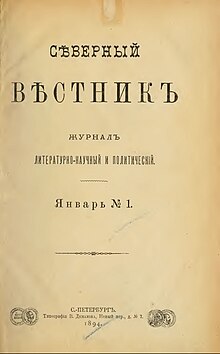Sewerny Westnik
Severny Westnik ( Russian Северный Вестник , German Nördlicher Bote or Nordic Bote ) was a Russian monthly magazine that appeared from September 1885 to 1898 in Saint Petersburg . In the subtitle it was called "Journal for Literature, Politics and Society". Many works by well-known Russian authors who always saw themselves as journalists, such as Leo Tolstoy , Alexander Pushkin , Fyodor Dostoyevsky or Anton Chekhov , were first published here, at least in part. The Nördlicher Bote deserves credit for having activated Russian modernism in mediation and in exchange with Central European literature and art by publishing many contemporary poets of Central European provenance in Russian translations.
Its name is derived from the Russian cultural self-image that Saint Petersburg, which is traditionally oriented towards the west , is perceived as being far north in relation to Russia .
history
Sewerny Westnik succeeded the booklet Otetschestwennye Sapiski (Patriotic Annals) , which was closed for political reasons in 1884 and whose editorial team was almost completely taken over. Parallel to this, Русская мысль ("Russian Thought") had already come onto the market in 1880 , which pursued a similarly liberal approach as Sěvernyj Vestnik. Two other sheets, Вестник Европы (“Europe's Messenger”) and Русское богатство (“Russian Prosperity”) from the same period even survived the turn of the century.
In 1885 Antonina Sabaschnikowa married. Jewreinowa the Severny Westnik as a magazine for literature , politics and society, which Anna Jewreinowa published and edited for five years until Sabashnikova had to sell the newspaper in 1890. In their first edition, the two women dubbed the magazine's goals as “close to the people and committed to the lowest strata of the Russian population”.
From January 1891 Lyubow Gurewitsch and Akim L. Wolynskij took over the management of the magazine. It has now been in charge of the latest Western European philosophy and the oeuvre of Russian symbolists . In 1898 the project was given up, mainly for economic reasons, but also because of the tightening of censorship conditions for the past two years . The number of subscribers, which in 1895 was well over 4,000, finally collapsed because the delivery of another sheet could no longer take place promptly.
This was followed by Mir Iskusstwa (World of Art), which was published in the penultimate edition of the Northern Messenger with an extensive review and was published by Akim Wolynskij from 1899 .
Complete copies outside of Russia are in short supply today. Even the Finnish National Library , which had the right to deposit copies during the Tsarist era, bridges the gaps with microfilm . The collection in the library of the Slavic Institute at the Ruprecht-Karls-Universität Heidelberg is fairly complete . Nine of the fourteen years have been completely preserved there.
construction
The volume of each issue was 500 pages and more per volume; the editions were not illustrated.
Each edition of Sěvernyj Vestnik is divided into two sections. The first part contains novels in continuation, as well as stories, plays, poems, essays, philosophical treatises, cultural reports, obituaries, etc. In Part II, the reader found sometimes extensive amounts with Russian-regional reference: for example about capitalism in the village , the beginnings of industrialization in coal mining and oil production or the situation of women in the east of the empire.
One of the special merits of the booklet is the rendition of the writings of Søren Kierkegaard and by and about Arthur Schopenhauer , Friedrich Nietzsche, published for the first time in Russia, and many book reviews of the works of Henrik Ibsen , August Strindberg , Charles Baudelaire , Guy de Maupassant , Edgar Allan Poe and not least Gerhart Hauptmann . The very popular works by Henryk Sienkiewicz as well as by Stefan Żeromski and Bolesław Prus have appeared from Poland . In order to meet the self-imposed all-encompassing claim, trivial literature was also a regular topic. In the rating of the magazine, it is given eclectic power.
literature
- Sěvernyj věstnik. Saint Petersburg 1804, OCLC 643173477 (Russian).
- Gorky Institute of World Literature Basic Digital Library of Russian Literature and Folklore (Russian)
- Cieślik Krzysztof: Siewiernyj wiestnik : zarys monograficzny, Volume 21 of Rozprawy i studia (Rorpawy i studia Wyźszej skoły pedagogicznej w Szczecinie. 21.); Publisher: Wydawn. Naukowe Wyźszej Szkoły Pedagogicznej, 1977.
swell
- Rosemarie Ziegler: Viennese Modernism in Slavic periodicals at the turn of the century. In: Severnyj Vestnik. Vienna 2006, p. 23 ff.
Remarks
- ↑ Pseudonym of the well-known literary, ballet and theater critic Chaim Flekser (1863–1926)
Individual evidence
- ↑ a b Friedrich Fiedler, Konstantin Azadovskiĭ: From the world of writers. Wallstein Verlag 1996, p. 574.
- ↑ Annotated story on the first publication of Chekhov's "The Steppe" ( Memento from May 14, 2009 in the Internet Archive ) in Sěvernyj Vestnik 1888, № 3, pp. 75–167.
- ^ Description of Chekhov's publications (Russian).
- ↑ Brockhaus-Efron : Евреинова (Анна Михайловна).
- ↑ Philosophical Faculty Bonn
- ^ Alexander Eliasberg: Russian literary history in individual portraits in the Gutenberg-DE project
